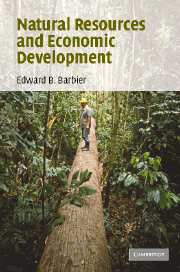Book contents
- Frontmatter
- Contents
- List of figures
- List of tables
- Acknowledgments
- Introduction
- 1 Natural resources and developing countries: an overview
- 2 Natural resource-based economic development in history
- 3 Does natural resource dependence hinder economic development?
- 4 Frontier expansion and economic development
- 5 Explaining land use change in developing countries
- 6 The economics of land conversion
- 7 Does water availability constrain economic development?
- 8 Rural poverty and resource degradation
- 9 Can frontier-based development be successful?
- 10 Policies for sustainable resource-based development in poor economies
- References
- Index
5 - Explaining land use change in developing countries
Published online by Cambridge University Press: 06 July 2010
- Frontmatter
- Contents
- List of figures
- List of tables
- Acknowledgments
- Introduction
- 1 Natural resources and developing countries: an overview
- 2 Natural resource-based economic development in history
- 3 Does natural resource dependence hinder economic development?
- 4 Frontier expansion and economic development
- 5 Explaining land use change in developing countries
- 6 The economics of land conversion
- 7 Does water availability constrain economic development?
- 8 Rural poverty and resource degradation
- 9 Can frontier-based development be successful?
- 10 Policies for sustainable resource-based development in poor economies
- References
- Index
Summary
The main aim of the first four chapters comprising Part One of this book was to address a key paradox facing present-day low and middle-income economies: why is it that, despite the importance of natural capital for sustainable economic development, increasing economic dependence on natural resource exploitation appears to be a hindrance to growth and development in poor countries?
Chapter 1 explained the importance of natural capital to sustainable economic development, and presented four key “stylized facts” of natural resource use in developing economies. Chapter 2 provided a historical overview of the role of natural resources in economic development. Chapter 3 reviewed current theories and hypotheses that attempt to explain why natural resource wealth may not be producing development benefits for poor countries. Finally, Chapter 4 was concerned with a new perspective on the resource-development paradox, which is termed the frontier expansion hypothesis.
As emphasized in these chapters forming Part One, deforestation, land conversion and agricultural land expansion in low and middle-income countries are major features of the economic development occurring in these economies. Much of the “frontier expansion” in these economies consists of rapid land use change, mostly the conversion of forests, woodlands and other natural habitats to agriculture and other land-based development activities.
The purpose of the following chapter is to explore in more detail the process of land conversion and agricultural land expansion itself as well as recent economic explanations as to the possible causes underlying this process.
- Type
- Chapter
- Information
- Natural Resources and Economic Development , pp. 185 - 208Publisher: Cambridge University PressPrint publication year: 2005



